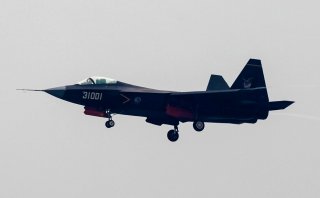Jet in a Jam: China’s Famous Stealth Fighter May Have a Problem
Not having a vertical take off ability could certainly limit a J-31 jet’s operational reach and effectiveness.
Can the fast emerging, carrier-launched Chinese J-31 fifth-generation stealthy aircraft truly rival the U.S. F-35C or F-35B fighter jet? The actual answer to this question may remain unknown or even somewhat mysterious, however, there do appear to be some unanswered questions which may answer or at least shed light upon this.
It would seem that any margin of difference is likely to reside in the realm of sensing, artificial-intelligence-enabled computing, weapons applications and, simply put, range. Whichever aircraft is able to see, detect and destroy the other first with longer-range, high-fidelity sensors and longer-range, precision-guided weapons is likely to prevail.
Certainly, a similarity between the external configuration or stealth characteristics noticeable by simply looking at the design, which does look like an F-35 jet, what about heat signature, sensor ranges, data organization or weapons reach? Answers to these unknown questions are likely to provide the answer. Detecting, tracking and destroying enemy aircraft at much farther standoff ranges, before it is detected itself, is a fundamental part of F-35 capacity. It is an ability that has thus far already proved extremely significant in wargames.
As a platform intended to launch from Chinese carriers, the FC-31 jet does not appear to operate with any kind of F-35B-like vertical take-off-and-landing, and any ability to parallel, replicate or in any way “match” the computing, sensing, and weapons capabilities of an F-35 jet, may be unknown.
Should amphibious assault ship-launched U.S. F-35B jets attack the Chinese Navy or defend Taiwan, Chinese surface assets may not be able to respond or match the threat without having one of its two aircraft carriers armed with the airplanes immediately available in the vicinity. Not having a vertical take off ability could certainly limit a J-31 jet’s operational reach and effectiveness.
While stealthy, the F-35 jet likely achieves its superiority as much through sensing, computing, data analysis, and software-enabled weapons attacks as it does with a stealthy exterior. To what extent might an FC-31 jet replicate this? That is perhaps unknown to a large degree, yet it might be a deciding or crucial factor when it comes to assessing the seriousness of the actual threat posed by the aircraft. There are many more aspects to stealth than external configuration or contours, as an ability to elude radar relies greatly on an ability to reduce or manage heat emissions, deliver or carry weapons and incorporate radar absorbent materials.
However, completely apart from the question of just how the J-31 jet might compare specifically to the F-35 jet, the existence of a Chinese stealthy, fifth-generation carrier-launched fighter is likely a threat the pentagon will doubtless take seriously. A J-31 jet will certainly increase power projection and attack capacity both regionally in places like the South China Sea as well as globally, given the pace at which China is adding new aircraft carriers.
Kris Osborn is the defense editor for the National Interest. Osborn previously served at the Pentagon as a Highly Qualified Expert with the Office of the Assistant Secretary of the Army—Acquisition, Logistics & Technology. Osborn has also worked as an anchor and on-air military specialist at national TV networks. He has appeared as a guest military expert on Fox News, MSNBC, The Military Channel, and The History Channel. He also has a Master's Degree in Comparative Literature from Columbia University.
Image: Reuters.

